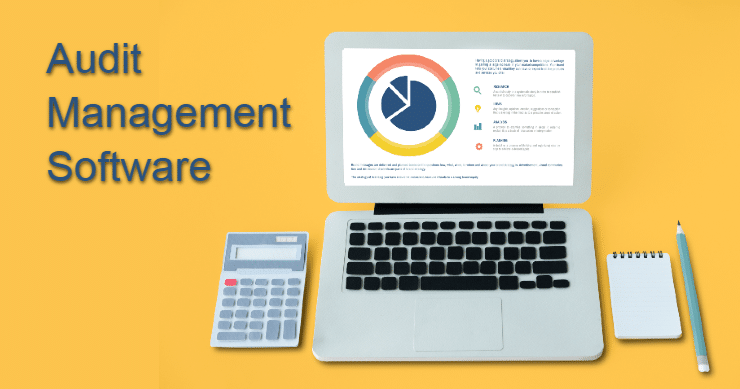What is Audit Management Software?
Audit management software is the cornerstone of organizations’ efficient audit oversight, governance, and procedural management. It streamlines the audit process from preparation to reporting and follow-up procedures, alleviating the challenges associated with manual methods. Audit management systems enhance traditional audit methodologies by automating workflows, centralizing documentation, facilitating third-party risk assessments, and improving efficiency and compliance.

Key Features to Look For in Audit Management Software
- Comprehensive Workflow Management: Seek software offering end-to-end workflow management capabilities, ensuring accountability and efficiency throughout the audit lifecycle.
- Customizable Templates and Forms: Prioritize software with customizable templates and forms to align with specific audit requirements, fostering adaptability and tailored solutions.
- Integration with Third-Party Tools: Choose software seamlessly integrating with other platforms, enhancing data consistency and collaboration across organizational systems.
- Real-Time Reporting and Analytics: Opt for software providing real-time reporting and analytics for informed decision-making, enabling proactive risk management and trend identification.
- User-Friendly Interface: Select software featuring an intuitive interface to facilitate adoption and usage across all stakeholders, minimizing training overhead and maximizing productivity.
- Audit Trail Capability: The evidence acquired is a significant factor in the outcome of your audit. After the tremendous investment in the certification and compliance process, laying the ground for a solid audit trail is the least you can do to ensure your efforts will be smooth and successful.
- Scalability and Flexibility: Ensure scalability and flexibility in software selection to accommodate organizational growth and evolving audit needs over time.
- Security and Compliance: Prioritize compliance audit management software with robust security measures and compliance features, safeguarding sensitive information and ensuring regulatory adherence.
Start Getting Value With
Centraleyes for Free
See for yourself how the Centraleyes platform exceeds anything an old GRC
system does and eliminates the need for manual processes and spreadsheets
to give you immediate value and run a full risk assessment in less than 30 days
Tips for Selecting an Audit Management Tool
- Define Requirements: Clearly outline organizational audit management needs, objectives, and priorities before exploring software options.
- Evaluate Multiple Options: Explore multiple auditing software for auditors, compare features, and gather feedback from stakeholders to make an informed decision.
- Consider Long-Term Value: Assess vendor reputation, customer support, and future scalability to ensure long-term value and return on investment.
- Trial and Test: Use free trials and demos to test software functionality in a real-world environment, gauging usability and suitability.
- Seek Expert Advice: Consult industry experts, consultants, and peers for insights and recommendations, leveraging their expertise to inform decision-making.
Regulatory Compliance Considerations
Audit management software ensures regulatory compliance across various industries and regions. Organizations face many regulatory requirements from healthcare to finance that govern data security, privacy, and financial reporting. Internal audit management software is a centralized platform for managing compliance initiatives, tracking regulatory changes, and demonstrating adherence to industry-specific standards.
- GDPR (General Data Protection Regulation): Governs personal data protection for individuals within the European Union.
- SOC 2 (Service Organization Control 2): Assesses the security, availability, processing integrity, confidentiality, and privacy of systems at a service organization.
- HIPAA (Health Insurance Portability and Accountability Act): Ensures the healthcare industry’s security and privacy of protected health information (PHI).
Automation of Compliance Monitoring and Reporting
Audit management software streamlines compliance monitoring, reporting, and documentation to simplify regulatory audits. Organizations can reduce manual effort, minimize errors, and ensure consistency in compliance efforts by automating routine tasks such as data collection, analysis, and reporting. Automated alerts and notifications inform stakeholders of compliance status, upcoming deadlines, and potential issues, enabling proactive risk management and remediation.
Integration and Interoperability
Integration and interoperability are essential for maximizing the effectiveness of audit management software. Audit management software can enhance data accuracy, consistency, and collaboration across departments by seamlessly connecting with other systems and tools within the organization’s technology ecosystem.
Seamless integration enhances data accuracy, consistency, and collaboration across departments by:
- Facilitating real-time data exchange and synchronization between systems.
- Eliminating duplicate data entry and manual reconciliation efforts.
- Providing a unified view of information for informed decision-making and audit planning.
- Streamlining communication and task assignment processes across teams.
Tips for Maximizing ROI
To maximize ROI from audit management software, organizations can:
- Optimize usage by providing comprehensive training and support to users at all levels of the organization.
- Leverage advanced features and capabilities to streamline audit workflows, automate repetitive tasks, and enhance efficiency.
- Continuously improve processes by soliciting user feedback, monitoring performance metrics, and implementing best practices.
- Evaluate and reassess the software periodically to ensure alignment with organizational goals, evolving needs, and industry standards.
By implementing these strategies, organizations can drive measurable business outcomes, including:
- Cost savings through efficiency gains and reduced audit-related expenses.
- Improved compliance and risk management outcomes enhance reputation and stakeholder trust.
- Greater agility and adaptability in responding to regulatory changes and industry disruptions.
- Enhanced decision-making and strategic planning based on actionable insights derived from audit data and analytics.
Start Getting Value With
Centraleyes for Free
See for yourself how the Centraleyes platform exceeds anything an old GRC
system does and eliminates the need for manual processes and spreadsheets
to give you immediate value and run a full risk assessment in less than 30 days





